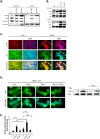PAK1 modulates a PPARγ/NF-κB cascade in intestinal inflammation
- PMID: 26036343
- PMCID: PMC4576212
- DOI: 10.1016/j.bbamcr.2015.05.031
PAK1 modulates a PPARγ/NF-κB cascade in intestinal inflammation
Abstract
P21-activated kinases (PAKs) are multifunctional effectors of Rho GTPases with both kinase and scaffolding activity. Here, we investigated the effects of inflammation on PAK1 signaling and its role in colitis-driven carcinogenesis. PAK1 and p-PAK1 (Thr423) were assessed by immunohistochemistry, immunofluorescence, and Western blot. C57BL6/J wildtype mice were treated with a single intraperitoneal TNFα injection. Small intestinal organoids from these mice and from PAK1-KO mice were cultured with TNFα. NF-κB and PPARγ were analyzed upon PAK1 overexpression and silencing for transcriptional/translational regulation. PAK1 expression and activation was increased on the luminal intestinal epithelial surface in inflammatory bowel disease and colitis-associated cancer. PAK1 was phosphorylated upon treatment with IFNγ, IL-1β, and TNFα. In vivo, mice administered with TNFα showed increased p-PAK1 in intestinal villi, which was associated with nuclear p65 and NF-κB activation. p65 nuclear translocation downstream of TNFα was strongly inhibited in PAK1-KO small intestinal organoids. PAK1 overexpression induced a PAK1-p65 interaction as visualized by co-immunoprecipitation, nuclear translocation, and increased NF-κB transactivation, all of which were impeded by kinase-dead PAK1. Moreover, PAK1 overexpression downregulated PPARγ and mesalamine recovered PPARγ through PAK1 inhibition. On the other hand PAK1 silencing inhibited NF-κB, which was recovered using BADGE, a PPARγ antagonist. Altogether these data demonstrate that PAK1 overexpression and activation in inflammation and colitis-associated cancer promote NF-κB activity via suppression of PPARγ in intestinal epithelial cells.
Keywords: Colitis-associated cancer; Inflammation; NF-κB; PAK1; PPARγ; Ulcerative colitis.
Copyright © 2015. Published by Elsevier B.V.
Figures











References
-
- Rubin D.T., Cruz-Correa M.R., Gasche C., Jass J.R., Lichtenstein G.R., Montgomery E.A., Riddell R.H., Rutter M.D., Ullman T.A., Velayos F.S., Itzkowitz S., A.S.A.i.C.C.P.M. Group Colorectal cancer prevention in inflammatory bowel disease and the role of 5-aminosalicylic acid: a clinical review and update. Inflamm. Bowel Dis. 2008;14:265–274. - PubMed
-
- Khare V., Lyakhovich A., Dammann K., Lang M., Borgmann M., Tichy B., Pospisilova S., Luciani G., Campregher C., Evstatiev R., Pflueger M., Hundsberger H., Gasche C. Mesalamine modulates intercellular adhesion through inhibition of p-21 activated kinase-1. Biochem. Pharmacol. 2013;85:234–244. - PMC - PubMed
-
- Parrini M.C., Lei M., Harrison S.C., Mayer B.J. Pak1 kinase homodimers are autoinhibited in trans and dissociated upon activation by Cdc42 and Rac1. Mol. Cell. 2002;9:73–83. - PubMed
-
- Kumar R., Gururaj A.E., Barnes C.J. p21-Activated kinases in cancer. Nat. Rev. Cancer. 2006;6:459–471. - PubMed
-
- Dammann K., Khare V., Gasche C. Tracing PAKs from GI inflammation to cancer. Gut. 2014;63:1173–1184. - PubMed
Publication types
MeSH terms
Substances
Grants and funding
LinkOut - more resources
Full Text Sources
Other Literature Sources
Molecular Biology Databases
Research Materials

